Analysis of Riverwood's Management and Strategic Challenges
VerifiedAdded on 2023/06/08
|14
|3564
|101
Report
AI Summary
This report delves into the strategic management challenges confronting Riverwood Logistics, a company facing issues related to organizational culture, innovation, and human resource management. The report begins by formulating research questions aimed at identifying the root causes of these challenges, particularly the lack of innovation and its impact on the company's competitiveness. To address these issues, the report explores relevant theories such as the generic theory of organizational culture, the McKinsey 7-S framework, and Porter's Generic Strategy model. It analyzes the strengths and weaknesses of each theory, discussing how they can be applied to Riverwood's specific context. The analysis includes a 5 Whys analysis to determine the root cause of challenges and also provides examples of other industries facing similar management problems. The report concludes with recommendations for improving Riverwood's strategic management, focusing on fostering a more innovative culture, enhancing human resource practices, and implementing effective strategies for competitive advantage. The report also emphasizes the importance of improving employee retention and attracting younger employees.
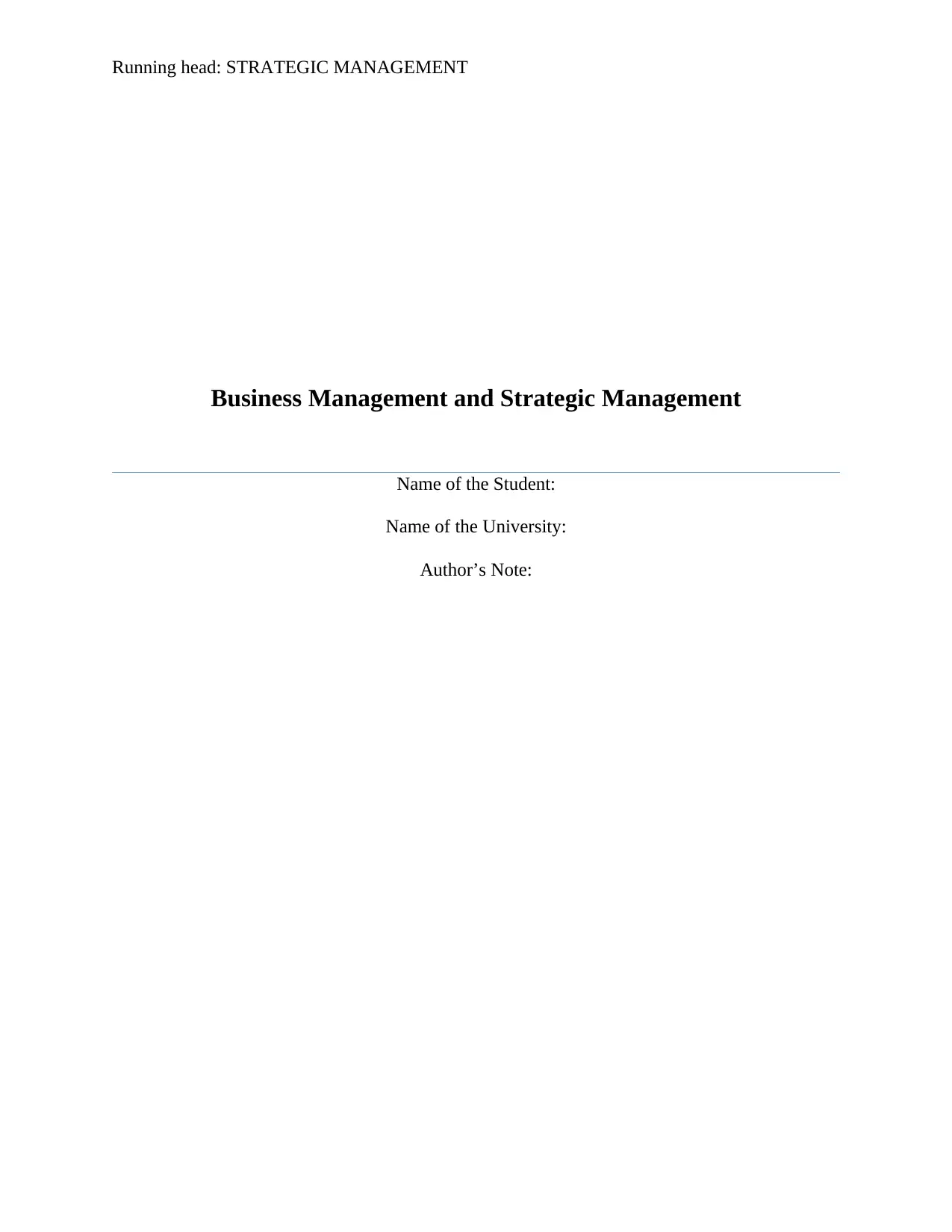
Running head: STRATEGIC MANAGEMENT
Business Management and Strategic Management
Name of the Student:
Name of the University:
Author’s Note:
Business Management and Strategic Management
Name of the Student:
Name of the University:
Author’s Note:
Paraphrase This Document
Need a fresh take? Get an instant paraphrase of this document with our AI Paraphraser
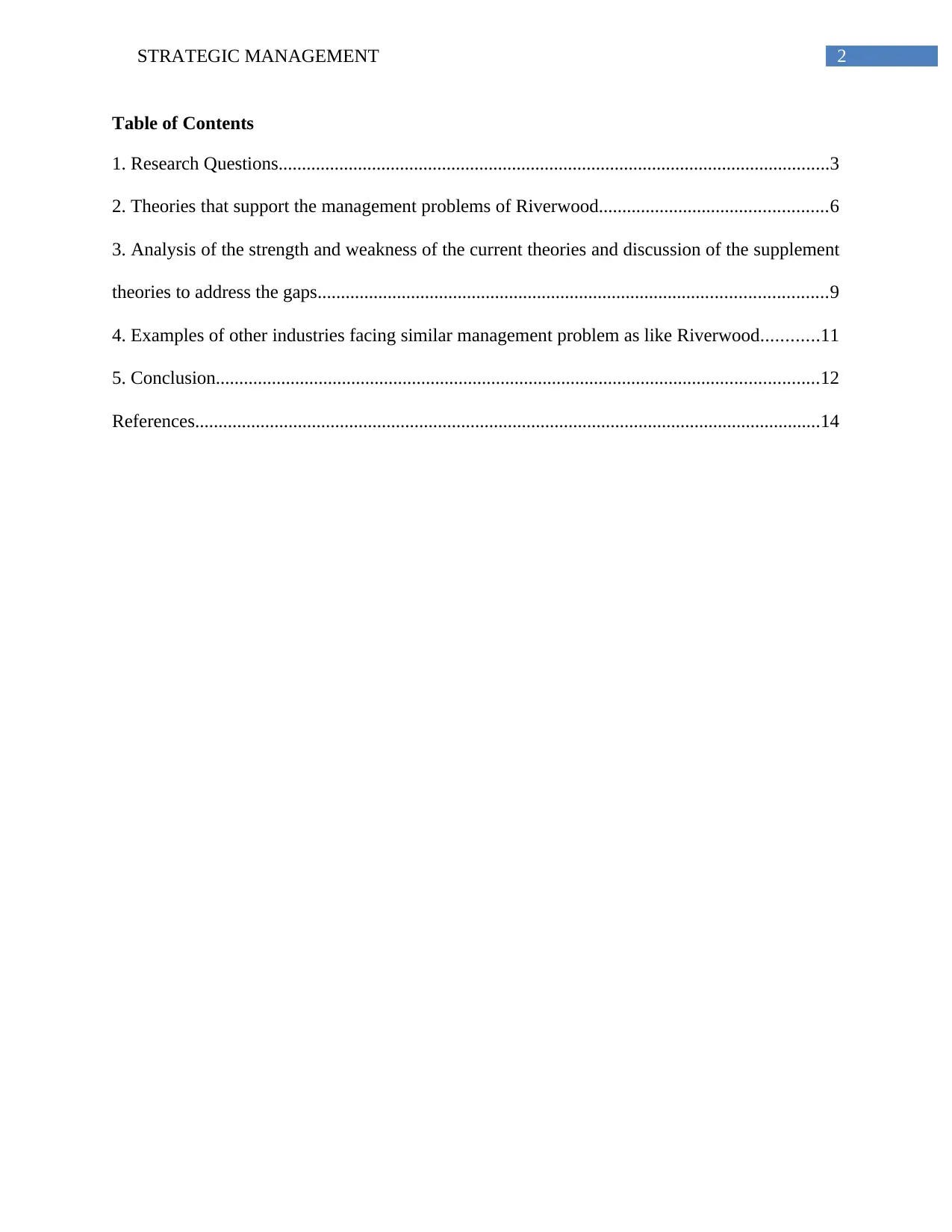
2STRATEGIC MANAGEMENT
Table of Contents
1. Research Questions......................................................................................................................3
2. Theories that support the management problems of Riverwood.................................................6
3. Analysis of the strength and weakness of the current theories and discussion of the supplement
theories to address the gaps.............................................................................................................9
4. Examples of other industries facing similar management problem as like Riverwood............11
5. Conclusion.................................................................................................................................12
References......................................................................................................................................14
Table of Contents
1. Research Questions......................................................................................................................3
2. Theories that support the management problems of Riverwood.................................................6
3. Analysis of the strength and weakness of the current theories and discussion of the supplement
theories to address the gaps.............................................................................................................9
4. Examples of other industries facing similar management problem as like Riverwood............11
5. Conclusion.................................................................................................................................12
References......................................................................................................................................14
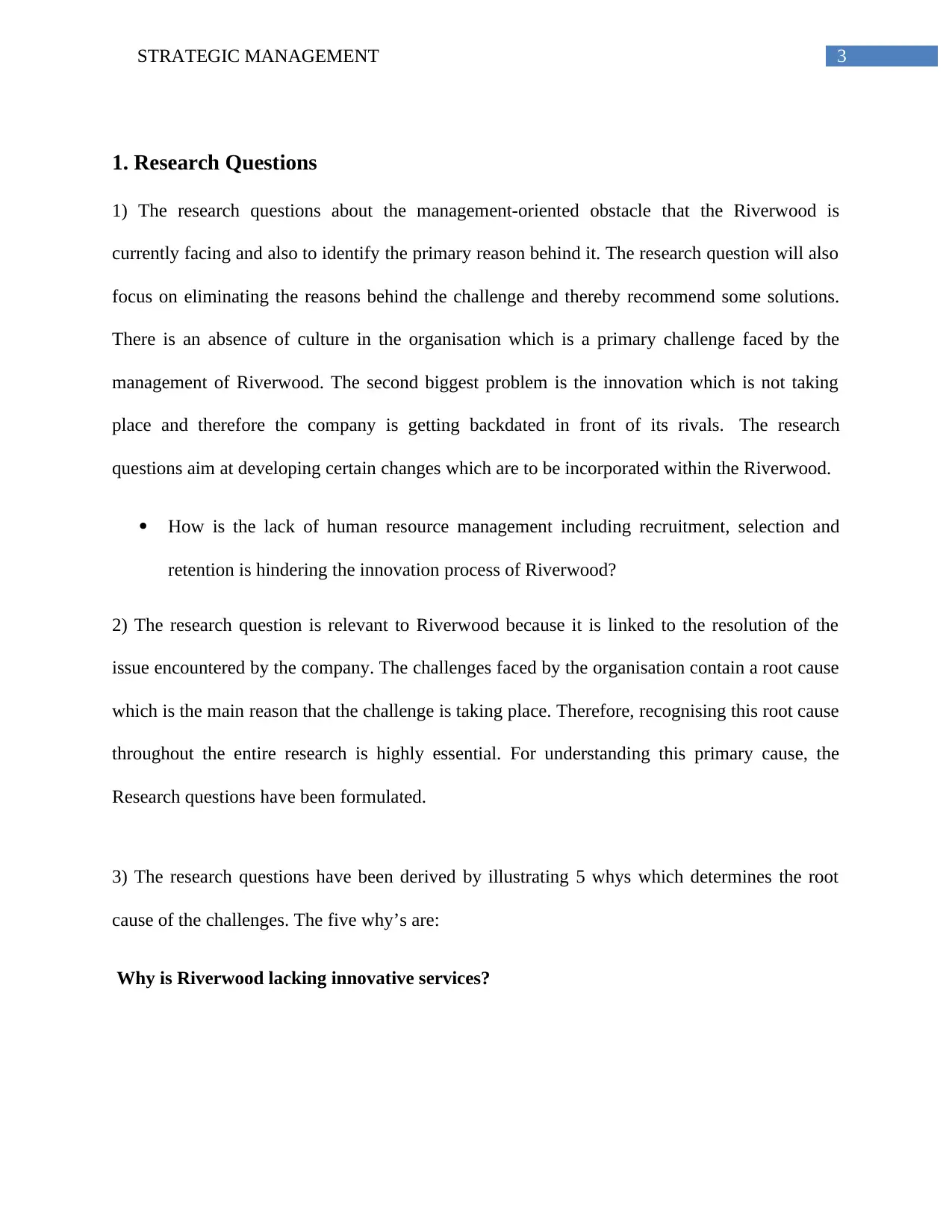
3STRATEGIC MANAGEMENT
1. Research Questions
1) The research questions about the management-oriented obstacle that the Riverwood is
currently facing and also to identify the primary reason behind it. The research question will also
focus on eliminating the reasons behind the challenge and thereby recommend some solutions.
There is an absence of culture in the organisation which is a primary challenge faced by the
management of Riverwood. The second biggest problem is the innovation which is not taking
place and therefore the company is getting backdated in front of its rivals. The research
questions aim at developing certain changes which are to be incorporated within the Riverwood.
How is the lack of human resource management including recruitment, selection and
retention is hindering the innovation process of Riverwood?
2) The research question is relevant to Riverwood because it is linked to the resolution of the
issue encountered by the company. The challenges faced by the organisation contain a root cause
which is the main reason that the challenge is taking place. Therefore, recognising this root cause
throughout the entire research is highly essential. For understanding this primary cause, the
Research questions have been formulated.
3) The research questions have been derived by illustrating 5 whys which determines the root
cause of the challenges. The five why’s are:
Why is Riverwood lacking innovative services?
1. Research Questions
1) The research questions about the management-oriented obstacle that the Riverwood is
currently facing and also to identify the primary reason behind it. The research question will also
focus on eliminating the reasons behind the challenge and thereby recommend some solutions.
There is an absence of culture in the organisation which is a primary challenge faced by the
management of Riverwood. The second biggest problem is the innovation which is not taking
place and therefore the company is getting backdated in front of its rivals. The research
questions aim at developing certain changes which are to be incorporated within the Riverwood.
How is the lack of human resource management including recruitment, selection and
retention is hindering the innovation process of Riverwood?
2) The research question is relevant to Riverwood because it is linked to the resolution of the
issue encountered by the company. The challenges faced by the organisation contain a root cause
which is the main reason that the challenge is taking place. Therefore, recognising this root cause
throughout the entire research is highly essential. For understanding this primary cause, the
Research questions have been formulated.
3) The research questions have been derived by illustrating 5 whys which determines the root
cause of the challenges. The five why’s are:
Why is Riverwood lacking innovative services?
⊘ This is a preview!⊘
Do you want full access?
Subscribe today to unlock all pages.

Trusted by 1+ million students worldwide
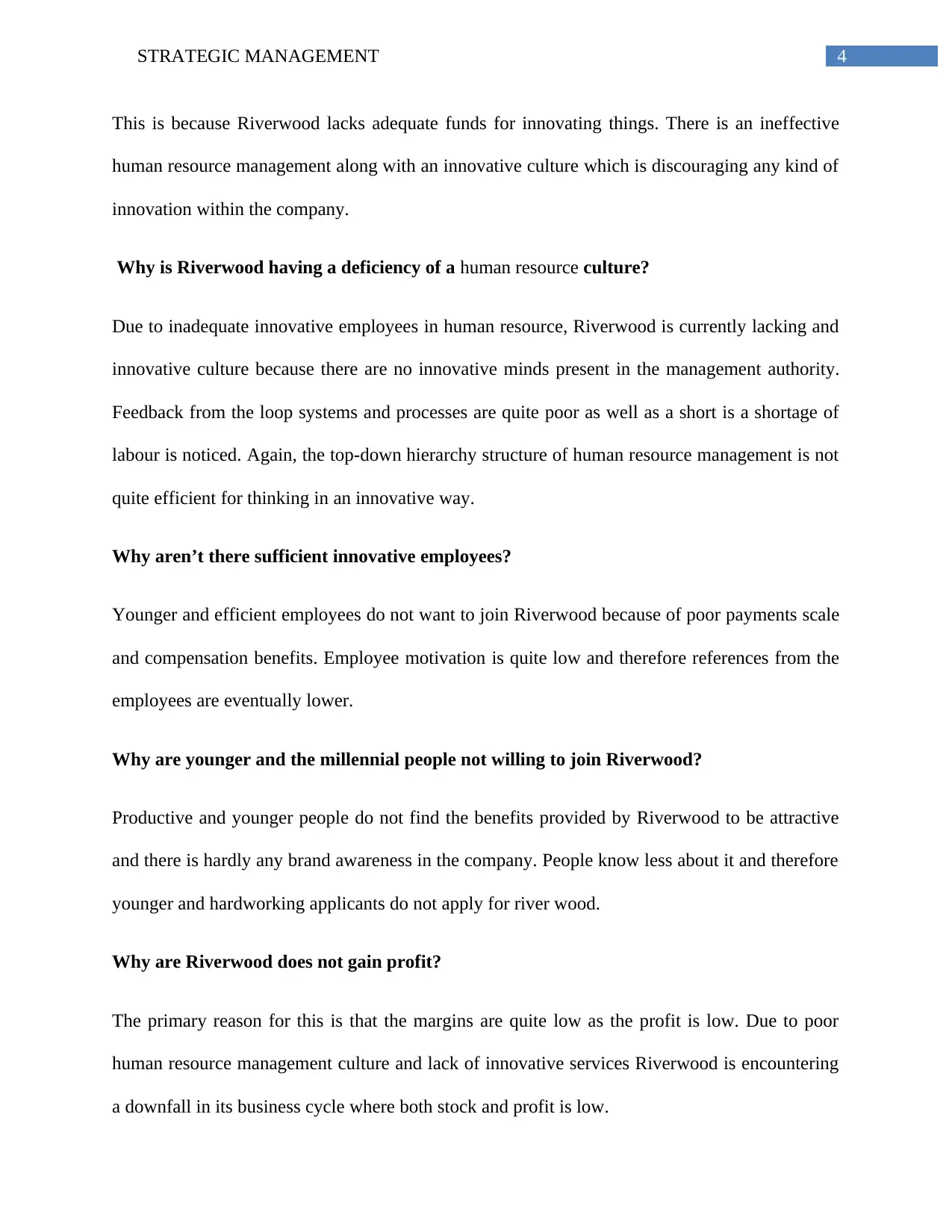
4STRATEGIC MANAGEMENT
This is because Riverwood lacks adequate funds for innovating things. There is an ineffective
human resource management along with an innovative culture which is discouraging any kind of
innovation within the company.
Why is Riverwood having a deficiency of a human resource culture?
Due to inadequate innovative employees in human resource, Riverwood is currently lacking and
innovative culture because there are no innovative minds present in the management authority.
Feedback from the loop systems and processes are quite poor as well as a short is a shortage of
labour is noticed. Again, the top-down hierarchy structure of human resource management is not
quite efficient for thinking in an innovative way.
Why aren’t there sufficient innovative employees?
Younger and efficient employees do not want to join Riverwood because of poor payments scale
and compensation benefits. Employee motivation is quite low and therefore references from the
employees are eventually lower.
Why are younger and the millennial people not willing to join Riverwood?
Productive and younger people do not find the benefits provided by Riverwood to be attractive
and there is hardly any brand awareness in the company. People know less about it and therefore
younger and hardworking applicants do not apply for river wood.
Why are Riverwood does not gain profit?
The primary reason for this is that the margins are quite low as the profit is low. Due to poor
human resource management culture and lack of innovative services Riverwood is encountering
a downfall in its business cycle where both stock and profit is low.
This is because Riverwood lacks adequate funds for innovating things. There is an ineffective
human resource management along with an innovative culture which is discouraging any kind of
innovation within the company.
Why is Riverwood having a deficiency of a human resource culture?
Due to inadequate innovative employees in human resource, Riverwood is currently lacking and
innovative culture because there are no innovative minds present in the management authority.
Feedback from the loop systems and processes are quite poor as well as a short is a shortage of
labour is noticed. Again, the top-down hierarchy structure of human resource management is not
quite efficient for thinking in an innovative way.
Why aren’t there sufficient innovative employees?
Younger and efficient employees do not want to join Riverwood because of poor payments scale
and compensation benefits. Employee motivation is quite low and therefore references from the
employees are eventually lower.
Why are younger and the millennial people not willing to join Riverwood?
Productive and younger people do not find the benefits provided by Riverwood to be attractive
and there is hardly any brand awareness in the company. People know less about it and therefore
younger and hardworking applicants do not apply for river wood.
Why are Riverwood does not gain profit?
The primary reason for this is that the margins are quite low as the profit is low. Due to poor
human resource management culture and lack of innovative services Riverwood is encountering
a downfall in its business cycle where both stock and profit is low.
Paraphrase This Document
Need a fresh take? Get an instant paraphrase of this document with our AI Paraphraser
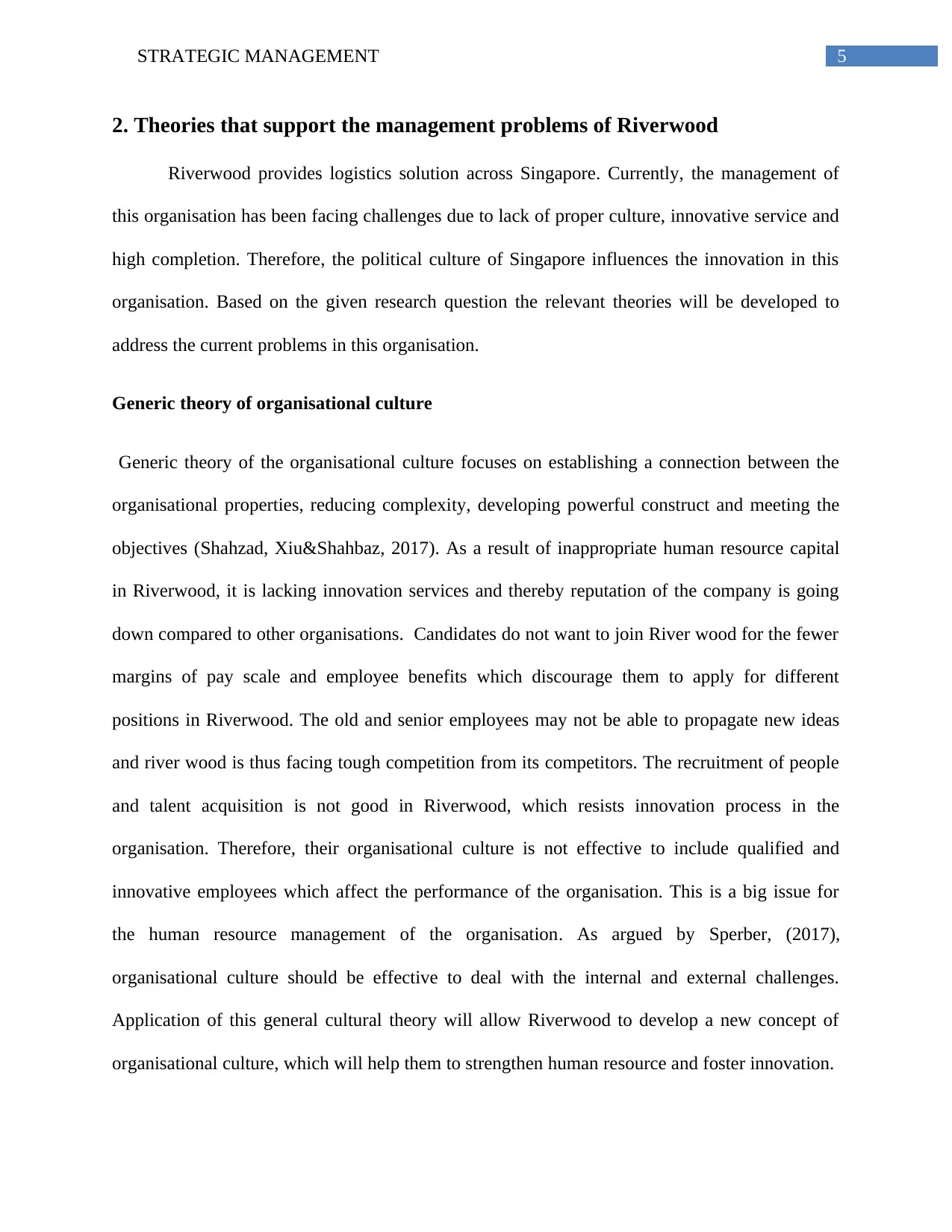
5STRATEGIC MANAGEMENT
2. Theories that support the management problems of Riverwood
Riverwood provides logistics solution across Singapore. Currently, the management of
this organisation has been facing challenges due to lack of proper culture, innovative service and
high completion. Therefore, the political culture of Singapore influences the innovation in this
organisation. Based on the given research question the relevant theories will be developed to
address the current problems in this organisation.
Generic theory of organisational culture
Generic theory of the organisational culture focuses on establishing a connection between the
organisational properties, reducing complexity, developing powerful construct and meeting the
objectives (Shahzad, Xiu&Shahbaz, 2017). As a result of inappropriate human resource capital
in Riverwood, it is lacking innovation services and thereby reputation of the company is going
down compared to other organisations. Candidates do not want to join River wood for the fewer
margins of pay scale and employee benefits which discourage them to apply for different
positions in Riverwood. The old and senior employees may not be able to propagate new ideas
and river wood is thus facing tough competition from its competitors. The recruitment of people
and talent acquisition is not good in Riverwood, which resists innovation process in the
organisation. Therefore, their organisational culture is not effective to include qualified and
innovative employees which affect the performance of the organisation. This is a big issue for
the human resource management of the organisation. As argued by Sperber, (2017),
organisational culture should be effective to deal with the internal and external challenges.
Application of this general cultural theory will allow Riverwood to develop a new concept of
organisational culture, which will help them to strengthen human resource and foster innovation.
2. Theories that support the management problems of Riverwood
Riverwood provides logistics solution across Singapore. Currently, the management of
this organisation has been facing challenges due to lack of proper culture, innovative service and
high completion. Therefore, the political culture of Singapore influences the innovation in this
organisation. Based on the given research question the relevant theories will be developed to
address the current problems in this organisation.
Generic theory of organisational culture
Generic theory of the organisational culture focuses on establishing a connection between the
organisational properties, reducing complexity, developing powerful construct and meeting the
objectives (Shahzad, Xiu&Shahbaz, 2017). As a result of inappropriate human resource capital
in Riverwood, it is lacking innovation services and thereby reputation of the company is going
down compared to other organisations. Candidates do not want to join River wood for the fewer
margins of pay scale and employee benefits which discourage them to apply for different
positions in Riverwood. The old and senior employees may not be able to propagate new ideas
and river wood is thus facing tough competition from its competitors. The recruitment of people
and talent acquisition is not good in Riverwood, which resists innovation process in the
organisation. Therefore, their organisational culture is not effective to include qualified and
innovative employees which affect the performance of the organisation. This is a big issue for
the human resource management of the organisation. As argued by Sperber, (2017),
organisational culture should be effective to deal with the internal and external challenges.
Application of this general cultural theory will allow Riverwood to develop a new concept of
organisational culture, which will help them to strengthen human resource and foster innovation.
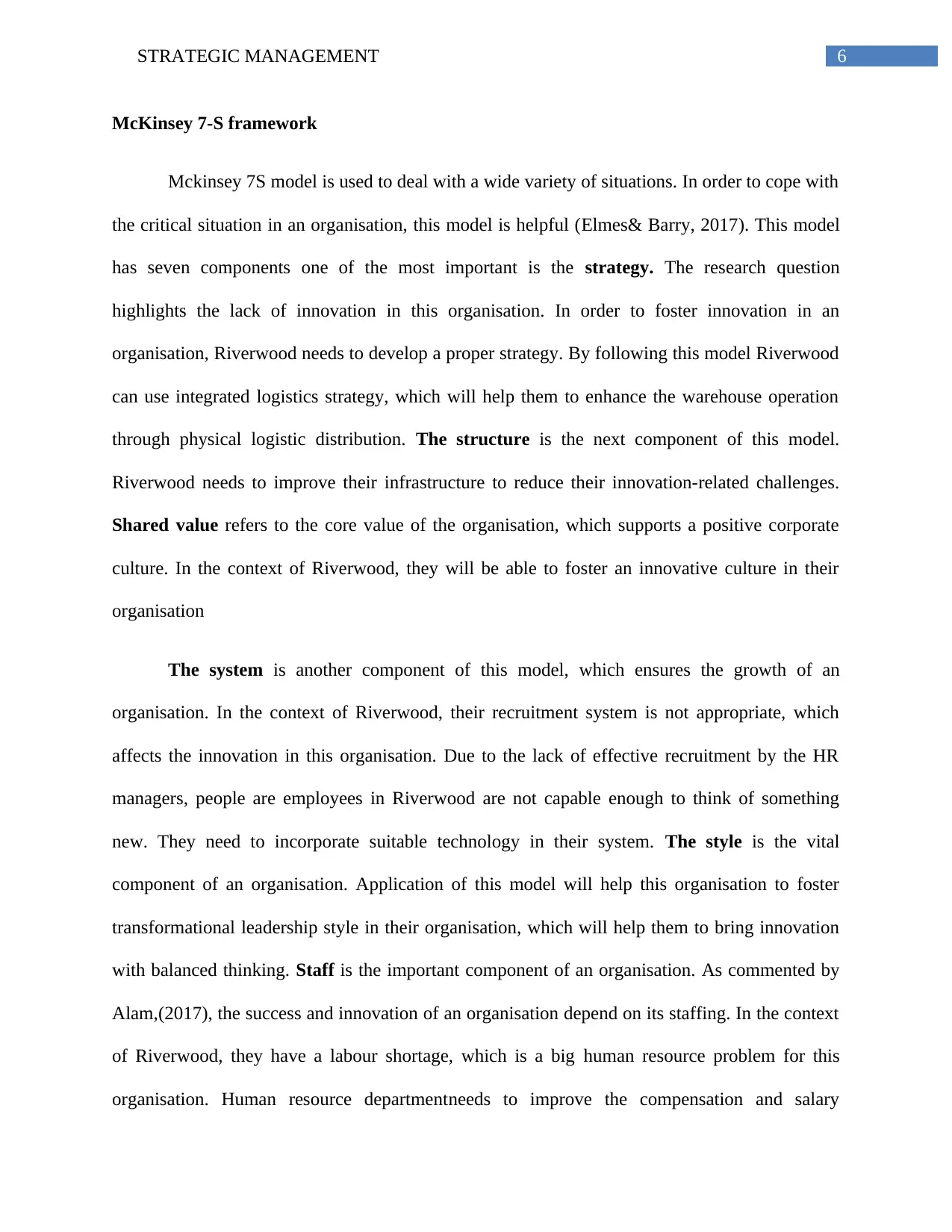
6STRATEGIC MANAGEMENT
McKinsey 7-S framework
Mckinsey 7S model is used to deal with a wide variety of situations. In order to cope with
the critical situation in an organisation, this model is helpful (Elmes& Barry, 2017). This model
has seven components one of the most important is the strategy. The research question
highlights the lack of innovation in this organisation. In order to foster innovation in an
organisation, Riverwood needs to develop a proper strategy. By following this model Riverwood
can use integrated logistics strategy, which will help them to enhance the warehouse operation
through physical logistic distribution. The structure is the next component of this model.
Riverwood needs to improve their infrastructure to reduce their innovation-related challenges.
Shared value refers to the core value of the organisation, which supports a positive corporate
culture. In the context of Riverwood, they will be able to foster an innovative culture in their
organisation
The system is another component of this model, which ensures the growth of an
organisation. In the context of Riverwood, their recruitment system is not appropriate, which
affects the innovation in this organisation. Due to the lack of effective recruitment by the HR
managers, people are employees in Riverwood are not capable enough to think of something
new. They need to incorporate suitable technology in their system. The style is the vital
component of an organisation. Application of this model will help this organisation to foster
transformational leadership style in their organisation, which will help them to bring innovation
with balanced thinking. Staff is the important component of an organisation. As commented by
Alam,(2017), the success and innovation of an organisation depend on its staffing. In the context
of Riverwood, they have a labour shortage, which is a big human resource problem for this
organisation. Human resource departmentneeds to improve the compensation and salary
McKinsey 7-S framework
Mckinsey 7S model is used to deal with a wide variety of situations. In order to cope with
the critical situation in an organisation, this model is helpful (Elmes& Barry, 2017). This model
has seven components one of the most important is the strategy. The research question
highlights the lack of innovation in this organisation. In order to foster innovation in an
organisation, Riverwood needs to develop a proper strategy. By following this model Riverwood
can use integrated logistics strategy, which will help them to enhance the warehouse operation
through physical logistic distribution. The structure is the next component of this model.
Riverwood needs to improve their infrastructure to reduce their innovation-related challenges.
Shared value refers to the core value of the organisation, which supports a positive corporate
culture. In the context of Riverwood, they will be able to foster an innovative culture in their
organisation
The system is another component of this model, which ensures the growth of an
organisation. In the context of Riverwood, their recruitment system is not appropriate, which
affects the innovation in this organisation. Due to the lack of effective recruitment by the HR
managers, people are employees in Riverwood are not capable enough to think of something
new. They need to incorporate suitable technology in their system. The style is the vital
component of an organisation. Application of this model will help this organisation to foster
transformational leadership style in their organisation, which will help them to bring innovation
with balanced thinking. Staff is the important component of an organisation. As commented by
Alam,(2017), the success and innovation of an organisation depend on its staffing. In the context
of Riverwood, they have a labour shortage, which is a big human resource problem for this
organisation. Human resource departmentneeds to improve the compensation and salary
⊘ This is a preview!⊘
Do you want full access?
Subscribe today to unlock all pages.

Trusted by 1+ million students worldwide
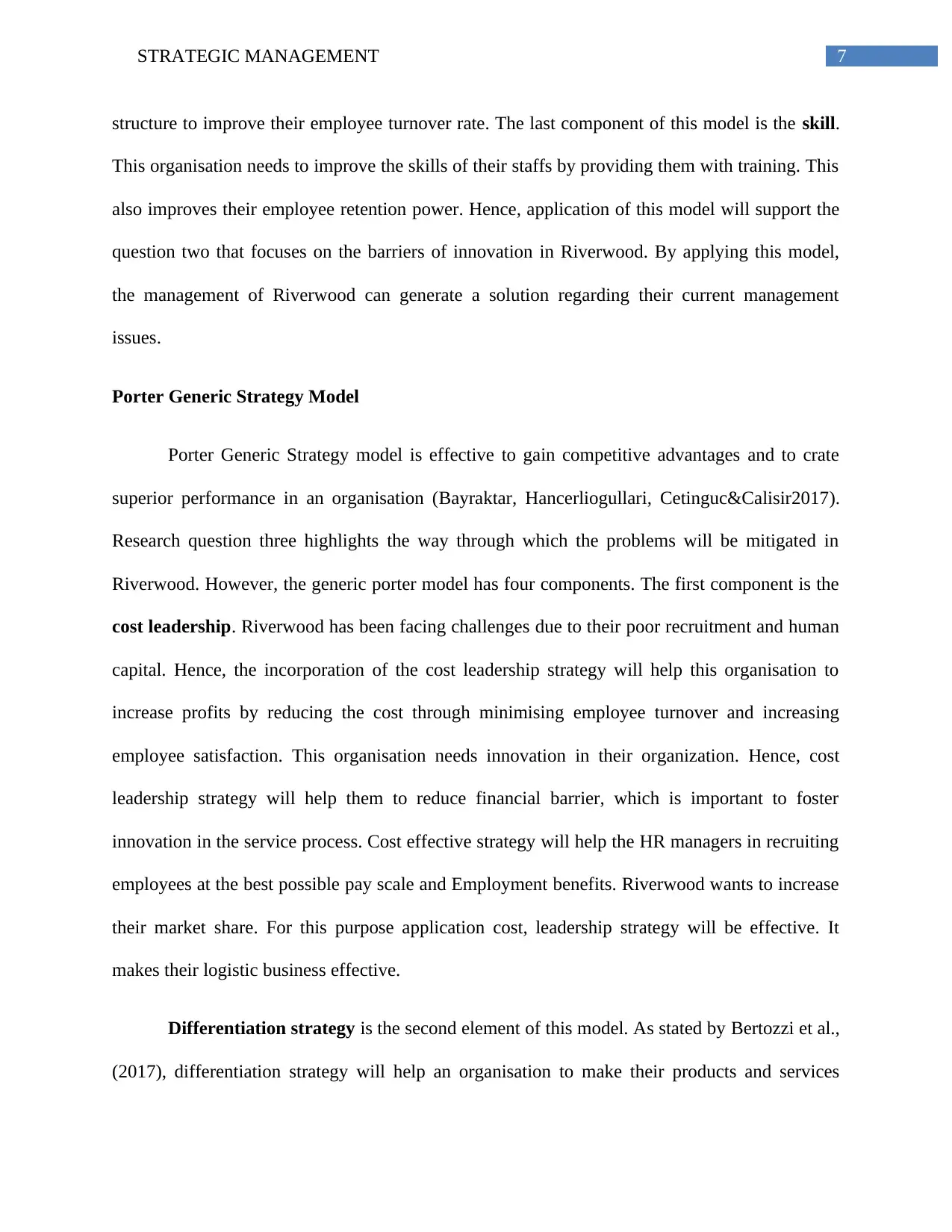
7STRATEGIC MANAGEMENT
structure to improve their employee turnover rate. The last component of this model is the skill.
This organisation needs to improve the skills of their staffs by providing them with training. This
also improves their employee retention power. Hence, application of this model will support the
question two that focuses on the barriers of innovation in Riverwood. By applying this model,
the management of Riverwood can generate a solution regarding their current management
issues.
Porter Generic Strategy Model
Porter Generic Strategy model is effective to gain competitive advantages and to crate
superior performance in an organisation (Bayraktar, Hancerliogullari, Cetinguc&Calisir2017).
Research question three highlights the way through which the problems will be mitigated in
Riverwood. However, the generic porter model has four components. The first component is the
cost leadership. Riverwood has been facing challenges due to their poor recruitment and human
capital. Hence, the incorporation of the cost leadership strategy will help this organisation to
increase profits by reducing the cost through minimising employee turnover and increasing
employee satisfaction. This organisation needs innovation in their organization. Hence, cost
leadership strategy will help them to reduce financial barrier, which is important to foster
innovation in the service process. Cost effective strategy will help the HR managers in recruiting
employees at the best possible pay scale and Employment benefits. Riverwood wants to increase
their market share. For this purpose application cost, leadership strategy will be effective. It
makes their logistic business effective.
Differentiation strategy is the second element of this model. As stated by Bertozzi et al.,
(2017), differentiation strategy will help an organisation to make their products and services
structure to improve their employee turnover rate. The last component of this model is the skill.
This organisation needs to improve the skills of their staffs by providing them with training. This
also improves their employee retention power. Hence, application of this model will support the
question two that focuses on the barriers of innovation in Riverwood. By applying this model,
the management of Riverwood can generate a solution regarding their current management
issues.
Porter Generic Strategy Model
Porter Generic Strategy model is effective to gain competitive advantages and to crate
superior performance in an organisation (Bayraktar, Hancerliogullari, Cetinguc&Calisir2017).
Research question three highlights the way through which the problems will be mitigated in
Riverwood. However, the generic porter model has four components. The first component is the
cost leadership. Riverwood has been facing challenges due to their poor recruitment and human
capital. Hence, the incorporation of the cost leadership strategy will help this organisation to
increase profits by reducing the cost through minimising employee turnover and increasing
employee satisfaction. This organisation needs innovation in their organization. Hence, cost
leadership strategy will help them to reduce financial barrier, which is important to foster
innovation in the service process. Cost effective strategy will help the HR managers in recruiting
employees at the best possible pay scale and Employment benefits. Riverwood wants to increase
their market share. For this purpose application cost, leadership strategy will be effective. It
makes their logistic business effective.
Differentiation strategy is the second element of this model. As stated by Bertozzi et al.,
(2017), differentiation strategy will help an organisation to make their products and services
Paraphrase This Document
Need a fresh take? Get an instant paraphrase of this document with our AI Paraphraser
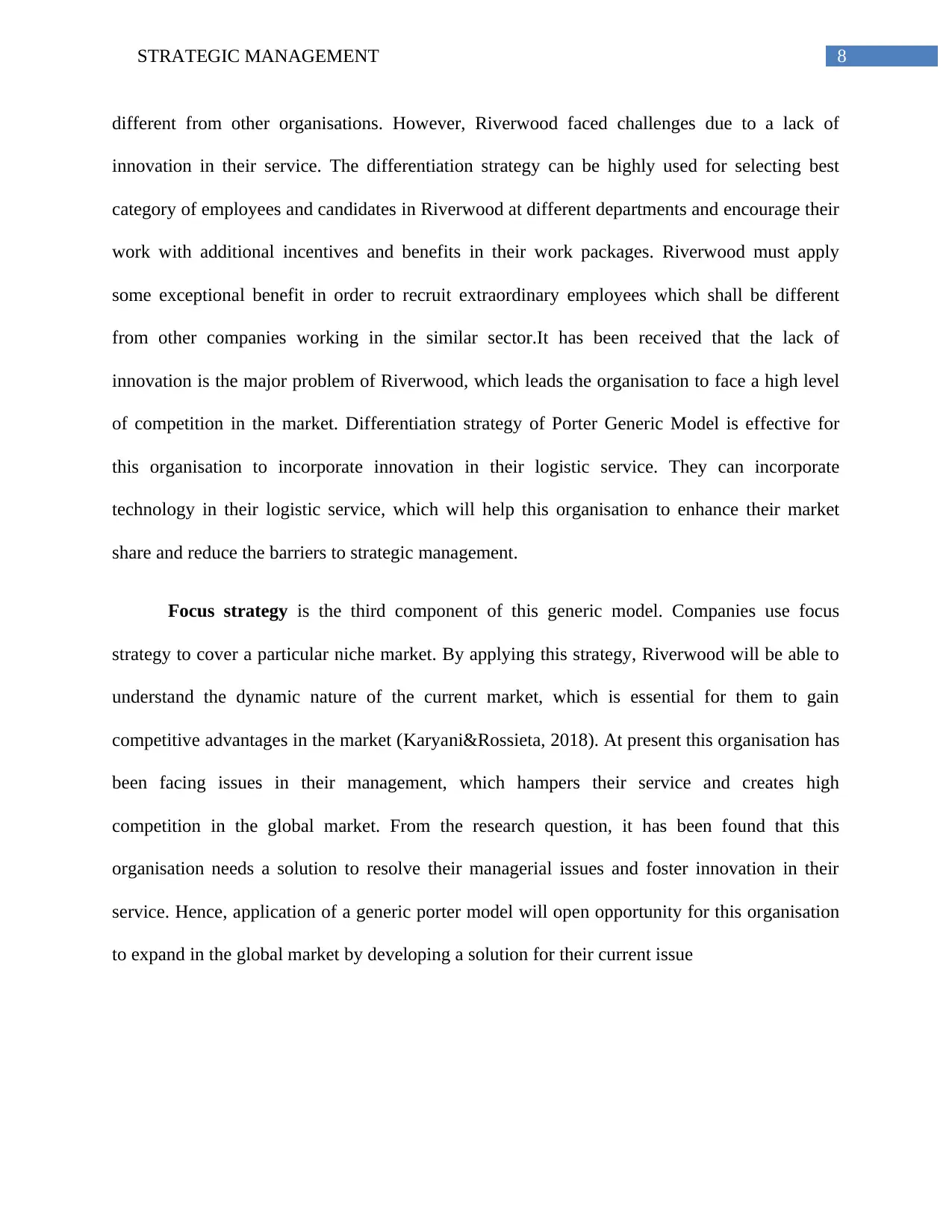
8STRATEGIC MANAGEMENT
different from other organisations. However, Riverwood faced challenges due to a lack of
innovation in their service. The differentiation strategy can be highly used for selecting best
category of employees and candidates in Riverwood at different departments and encourage their
work with additional incentives and benefits in their work packages. Riverwood must apply
some exceptional benefit in order to recruit extraordinary employees which shall be different
from other companies working in the similar sector.It has been received that the lack of
innovation is the major problem of Riverwood, which leads the organisation to face a high level
of competition in the market. Differentiation strategy of Porter Generic Model is effective for
this organisation to incorporate innovation in their logistic service. They can incorporate
technology in their logistic service, which will help this organisation to enhance their market
share and reduce the barriers to strategic management.
Focus strategy is the third component of this generic model. Companies use focus
strategy to cover a particular niche market. By applying this strategy, Riverwood will be able to
understand the dynamic nature of the current market, which is essential for them to gain
competitive advantages in the market (Karyani&Rossieta, 2018). At present this organisation has
been facing issues in their management, which hampers their service and creates high
competition in the global market. From the research question, it has been found that this
organisation needs a solution to resolve their managerial issues and foster innovation in their
service. Hence, application of a generic porter model will open opportunity for this organisation
to expand in the global market by developing a solution for their current issue
different from other organisations. However, Riverwood faced challenges due to a lack of
innovation in their service. The differentiation strategy can be highly used for selecting best
category of employees and candidates in Riverwood at different departments and encourage their
work with additional incentives and benefits in their work packages. Riverwood must apply
some exceptional benefit in order to recruit extraordinary employees which shall be different
from other companies working in the similar sector.It has been received that the lack of
innovation is the major problem of Riverwood, which leads the organisation to face a high level
of competition in the market. Differentiation strategy of Porter Generic Model is effective for
this organisation to incorporate innovation in their logistic service. They can incorporate
technology in their logistic service, which will help this organisation to enhance their market
share and reduce the barriers to strategic management.
Focus strategy is the third component of this generic model. Companies use focus
strategy to cover a particular niche market. By applying this strategy, Riverwood will be able to
understand the dynamic nature of the current market, which is essential for them to gain
competitive advantages in the market (Karyani&Rossieta, 2018). At present this organisation has
been facing issues in their management, which hampers their service and creates high
competition in the global market. From the research question, it has been found that this
organisation needs a solution to resolve their managerial issues and foster innovation in their
service. Hence, application of a generic porter model will open opportunity for this organisation
to expand in the global market by developing a solution for their current issue
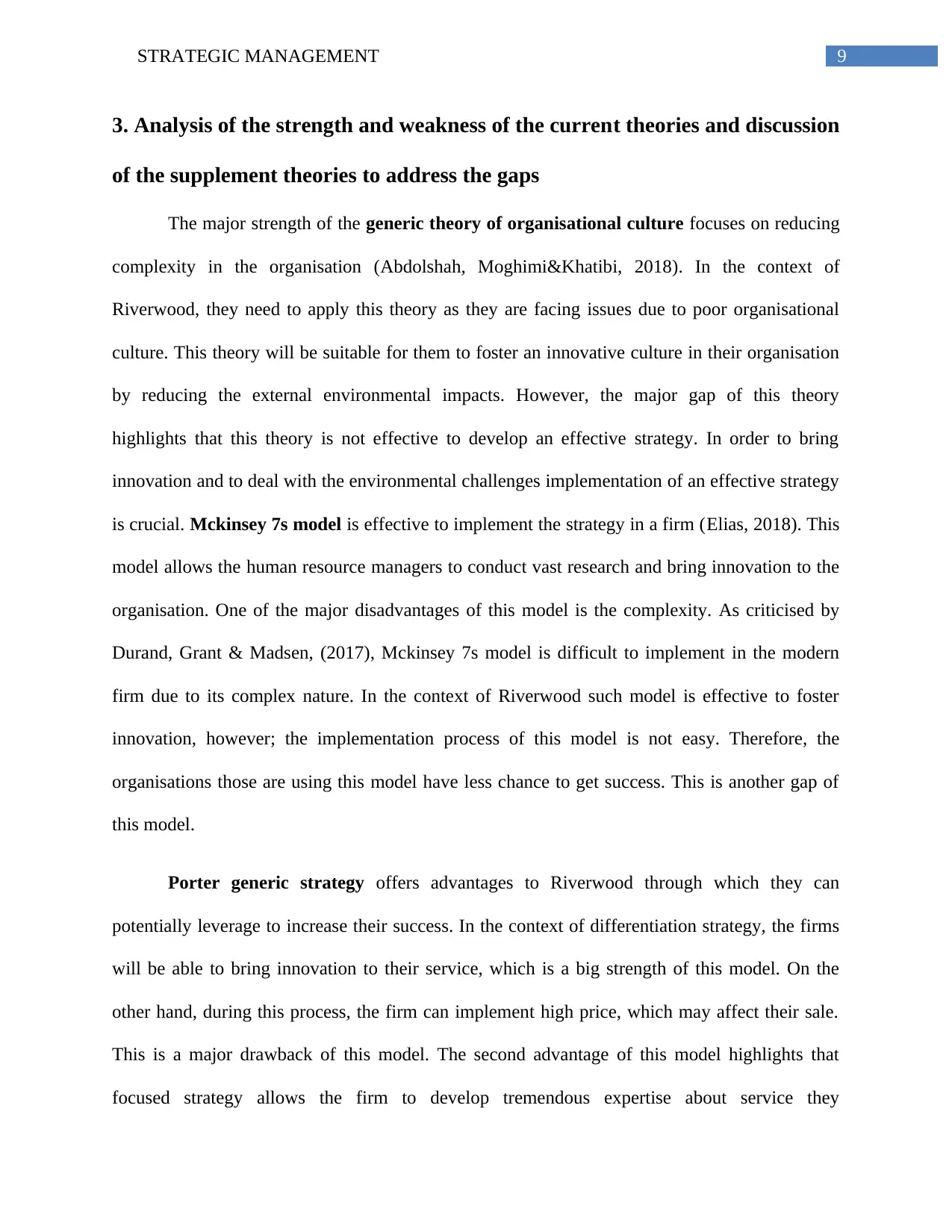
9STRATEGIC MANAGEMENT
3. Analysis of the strength and weakness of the current theories and discussion
of the supplement theories to address the gaps
The major strength of the generic theory of organisational culture focuses on reducing
complexity in the organisation (Abdolshah, Moghimi&Khatibi, 2018). In the context of
Riverwood, they need to apply this theory as they are facing issues due to poor organisational
culture. This theory will be suitable for them to foster an innovative culture in their organisation
by reducing the external environmental impacts. However, the major gap of this theory
highlights that this theory is not effective to develop an effective strategy. In order to bring
innovation and to deal with the environmental challenges implementation of an effective strategy
is crucial. Mckinsey 7s model is effective to implement the strategy in a firm (Elias, 2018). This
model allows the human resource managers to conduct vast research and bring innovation to the
organisation. One of the major disadvantages of this model is the complexity. As criticised by
Durand, Grant & Madsen, (2017), Mckinsey 7s model is difficult to implement in the modern
firm due to its complex nature. In the context of Riverwood such model is effective to foster
innovation, however; the implementation process of this model is not easy. Therefore, the
organisations those are using this model have less chance to get success. This is another gap of
this model.
Porter generic strategy offers advantages to Riverwood through which they can
potentially leverage to increase their success. In the context of differentiation strategy, the firms
will be able to bring innovation to their service, which is a big strength of this model. On the
other hand, during this process, the firm can implement high price, which may affect their sale.
This is a major drawback of this model. The second advantage of this model highlights that
focused strategy allows the firm to develop tremendous expertise about service they
3. Analysis of the strength and weakness of the current theories and discussion
of the supplement theories to address the gaps
The major strength of the generic theory of organisational culture focuses on reducing
complexity in the organisation (Abdolshah, Moghimi&Khatibi, 2018). In the context of
Riverwood, they need to apply this theory as they are facing issues due to poor organisational
culture. This theory will be suitable for them to foster an innovative culture in their organisation
by reducing the external environmental impacts. However, the major gap of this theory
highlights that this theory is not effective to develop an effective strategy. In order to bring
innovation and to deal with the environmental challenges implementation of an effective strategy
is crucial. Mckinsey 7s model is effective to implement the strategy in a firm (Elias, 2018). This
model allows the human resource managers to conduct vast research and bring innovation to the
organisation. One of the major disadvantages of this model is the complexity. As criticised by
Durand, Grant & Madsen, (2017), Mckinsey 7s model is difficult to implement in the modern
firm due to its complex nature. In the context of Riverwood such model is effective to foster
innovation, however; the implementation process of this model is not easy. Therefore, the
organisations those are using this model have less chance to get success. This is another gap of
this model.
Porter generic strategy offers advantages to Riverwood through which they can
potentially leverage to increase their success. In the context of differentiation strategy, the firms
will be able to bring innovation to their service, which is a big strength of this model. On the
other hand, during this process, the firm can implement high price, which may affect their sale.
This is a major drawback of this model. The second advantage of this model highlights that
focused strategy allows the firm to develop tremendous expertise about service they
⊘ This is a preview!⊘
Do you want full access?
Subscribe today to unlock all pages.

Trusted by 1+ million students worldwide
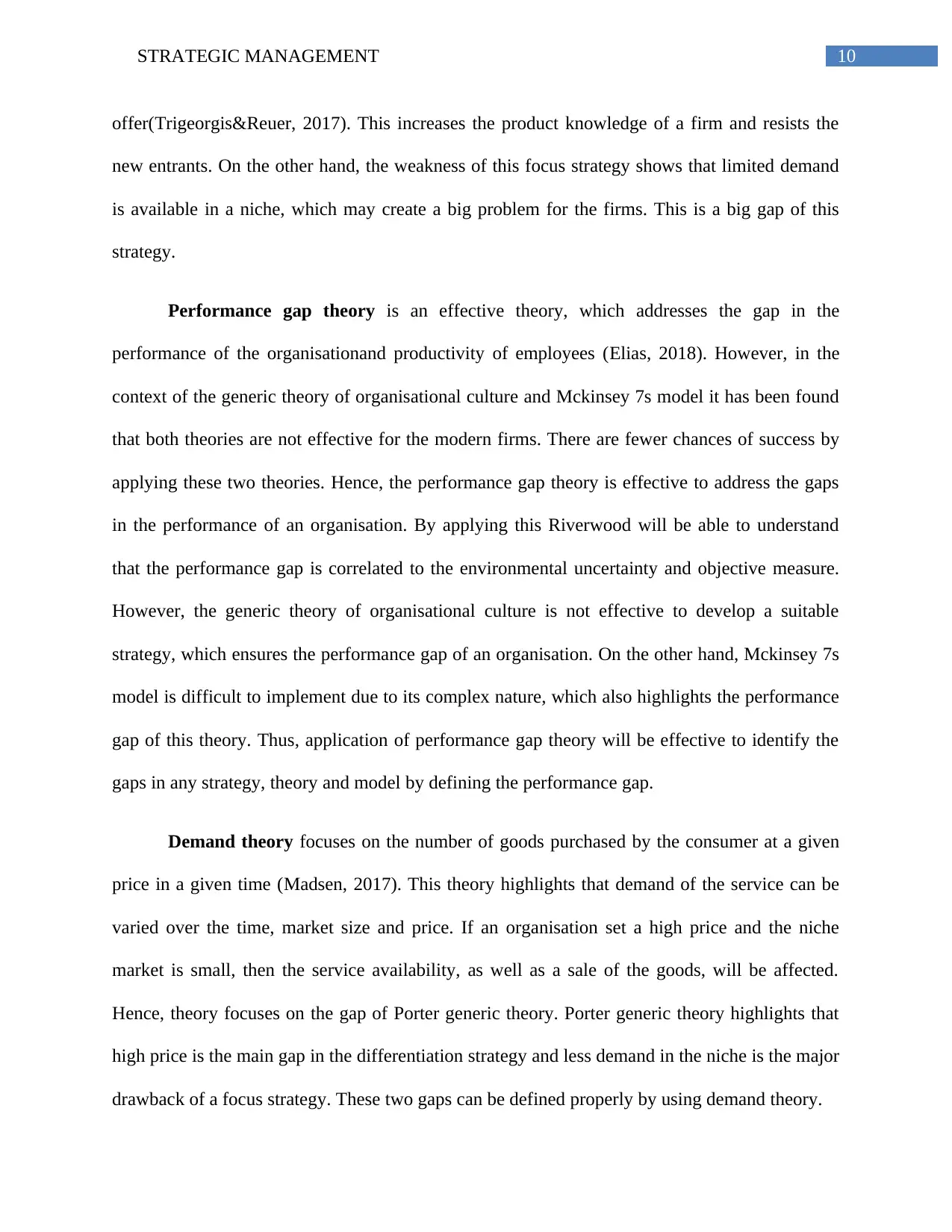
10STRATEGIC MANAGEMENT
offer(Trigeorgis&Reuer, 2017). This increases the product knowledge of a firm and resists the
new entrants. On the other hand, the weakness of this focus strategy shows that limited demand
is available in a niche, which may create a big problem for the firms. This is a big gap of this
strategy.
Performance gap theory is an effective theory, which addresses the gap in the
performance of the organisationand productivity of employees (Elias, 2018). However, in the
context of the generic theory of organisational culture and Mckinsey 7s model it has been found
that both theories are not effective for the modern firms. There are fewer chances of success by
applying these two theories. Hence, the performance gap theory is effective to address the gaps
in the performance of an organisation. By applying this Riverwood will be able to understand
that the performance gap is correlated to the environmental uncertainty and objective measure.
However, the generic theory of organisational culture is not effective to develop a suitable
strategy, which ensures the performance gap of an organisation. On the other hand, Mckinsey 7s
model is difficult to implement due to its complex nature, which also highlights the performance
gap of this theory. Thus, application of performance gap theory will be effective to identify the
gaps in any strategy, theory and model by defining the performance gap.
Demand theory focuses on the number of goods purchased by the consumer at a given
price in a given time (Madsen, 2017). This theory highlights that demand of the service can be
varied over the time, market size and price. If an organisation set a high price and the niche
market is small, then the service availability, as well as a sale of the goods, will be affected.
Hence, theory focuses on the gap of Porter generic theory. Porter generic theory highlights that
high price is the main gap in the differentiation strategy and less demand in the niche is the major
drawback of a focus strategy. These two gaps can be defined properly by using demand theory.
offer(Trigeorgis&Reuer, 2017). This increases the product knowledge of a firm and resists the
new entrants. On the other hand, the weakness of this focus strategy shows that limited demand
is available in a niche, which may create a big problem for the firms. This is a big gap of this
strategy.
Performance gap theory is an effective theory, which addresses the gap in the
performance of the organisationand productivity of employees (Elias, 2018). However, in the
context of the generic theory of organisational culture and Mckinsey 7s model it has been found
that both theories are not effective for the modern firms. There are fewer chances of success by
applying these two theories. Hence, the performance gap theory is effective to address the gaps
in the performance of an organisation. By applying this Riverwood will be able to understand
that the performance gap is correlated to the environmental uncertainty and objective measure.
However, the generic theory of organisational culture is not effective to develop a suitable
strategy, which ensures the performance gap of an organisation. On the other hand, Mckinsey 7s
model is difficult to implement due to its complex nature, which also highlights the performance
gap of this theory. Thus, application of performance gap theory will be effective to identify the
gaps in any strategy, theory and model by defining the performance gap.
Demand theory focuses on the number of goods purchased by the consumer at a given
price in a given time (Madsen, 2017). This theory highlights that demand of the service can be
varied over the time, market size and price. If an organisation set a high price and the niche
market is small, then the service availability, as well as a sale of the goods, will be affected.
Hence, theory focuses on the gap of Porter generic theory. Porter generic theory highlights that
high price is the main gap in the differentiation strategy and less demand in the niche is the major
drawback of a focus strategy. These two gaps can be defined properly by using demand theory.
Paraphrase This Document
Need a fresh take? Get an instant paraphrase of this document with our AI Paraphraser
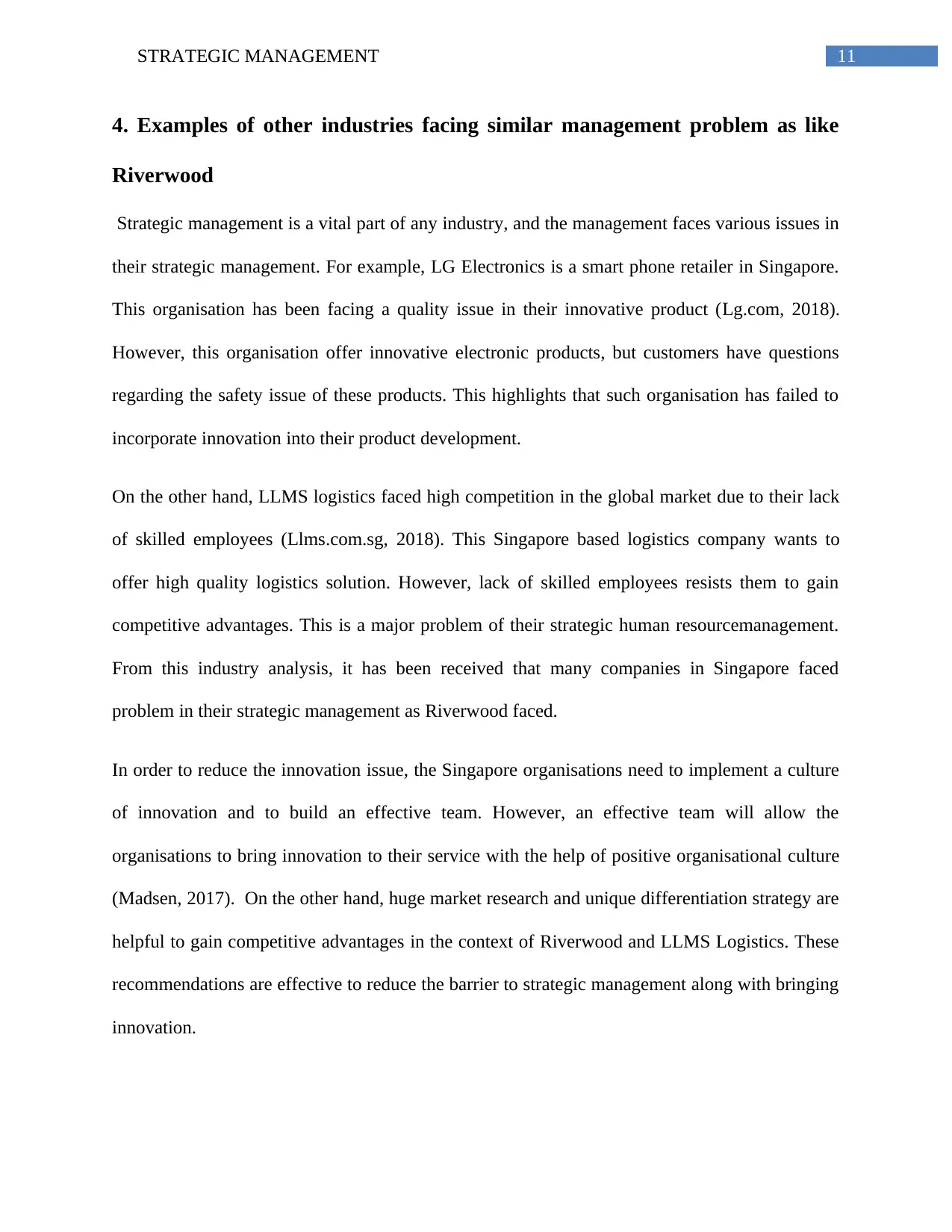
11STRATEGIC MANAGEMENT
4. Examples of other industries facing similar management problem as like
Riverwood
Strategic management is a vital part of any industry, and the management faces various issues in
their strategic management. For example, LG Electronics is a smart phone retailer in Singapore.
This organisation has been facing a quality issue in their innovative product (Lg.com, 2018).
However, this organisation offer innovative electronic products, but customers have questions
regarding the safety issue of these products. This highlights that such organisation has failed to
incorporate innovation into their product development.
On the other hand, LLMS logistics faced high competition in the global market due to their lack
of skilled employees (Llms.com.sg, 2018). This Singapore based logistics company wants to
offer high quality logistics solution. However, lack of skilled employees resists them to gain
competitive advantages. This is a major problem of their strategic human resourcemanagement.
From this industry analysis, it has been received that many companies in Singapore faced
problem in their strategic management as Riverwood faced.
In order to reduce the innovation issue, the Singapore organisations need to implement a culture
of innovation and to build an effective team. However, an effective team will allow the
organisations to bring innovation to their service with the help of positive organisational culture
(Madsen, 2017). On the other hand, huge market research and unique differentiation strategy are
helpful to gain competitive advantages in the context of Riverwood and LLMS Logistics. These
recommendations are effective to reduce the barrier to strategic management along with bringing
innovation.
4. Examples of other industries facing similar management problem as like
Riverwood
Strategic management is a vital part of any industry, and the management faces various issues in
their strategic management. For example, LG Electronics is a smart phone retailer in Singapore.
This organisation has been facing a quality issue in their innovative product (Lg.com, 2018).
However, this organisation offer innovative electronic products, but customers have questions
regarding the safety issue of these products. This highlights that such organisation has failed to
incorporate innovation into their product development.
On the other hand, LLMS logistics faced high competition in the global market due to their lack
of skilled employees (Llms.com.sg, 2018). This Singapore based logistics company wants to
offer high quality logistics solution. However, lack of skilled employees resists them to gain
competitive advantages. This is a major problem of their strategic human resourcemanagement.
From this industry analysis, it has been received that many companies in Singapore faced
problem in their strategic management as Riverwood faced.
In order to reduce the innovation issue, the Singapore organisations need to implement a culture
of innovation and to build an effective team. However, an effective team will allow the
organisations to bring innovation to their service with the help of positive organisational culture
(Madsen, 2017). On the other hand, huge market research and unique differentiation strategy are
helpful to gain competitive advantages in the context of Riverwood and LLMS Logistics. These
recommendations are effective to reduce the barrier to strategic management along with bringing
innovation.
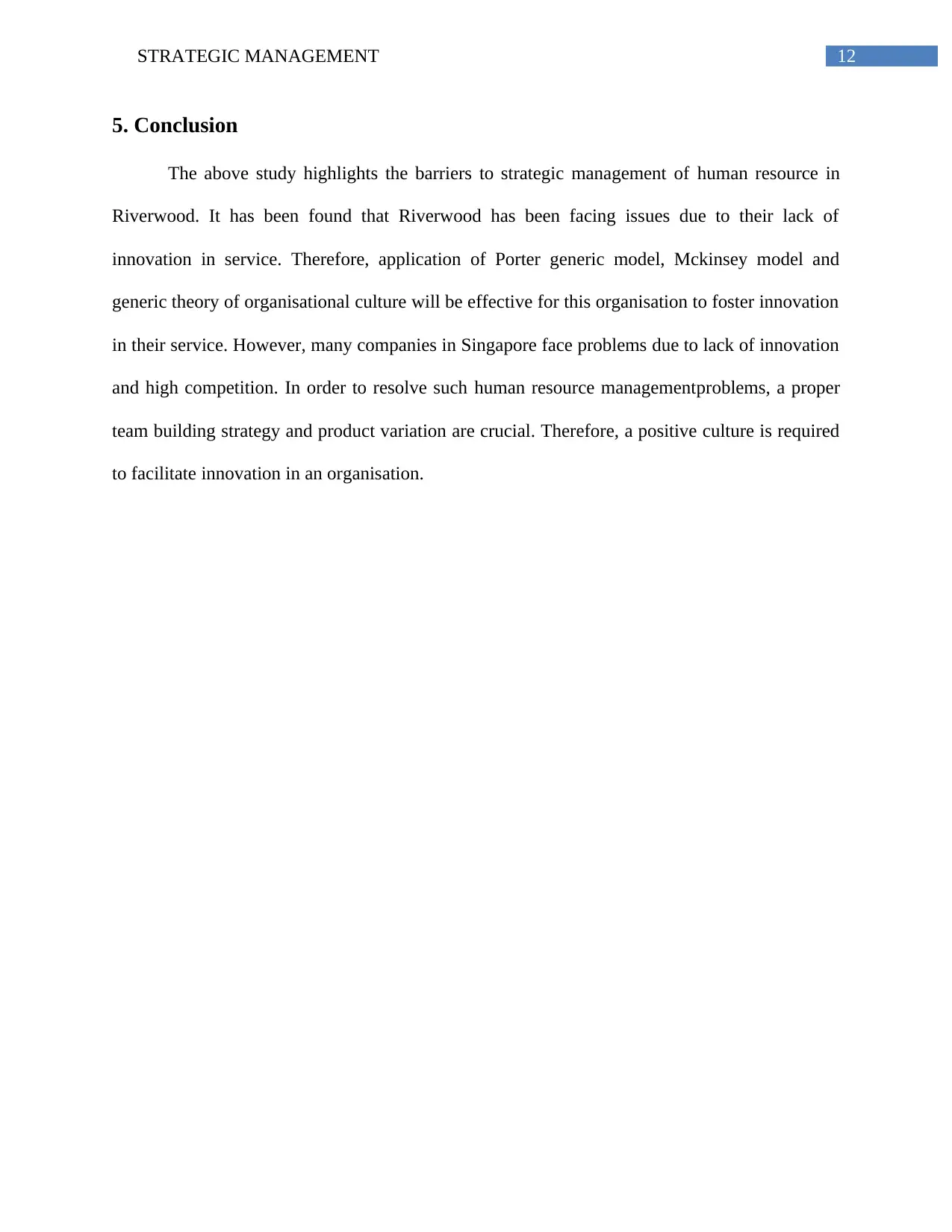
12STRATEGIC MANAGEMENT
5. Conclusion
The above study highlights the barriers to strategic management of human resource in
Riverwood. It has been found that Riverwood has been facing issues due to their lack of
innovation in service. Therefore, application of Porter generic model, Mckinsey model and
generic theory of organisational culture will be effective for this organisation to foster innovation
in their service. However, many companies in Singapore face problems due to lack of innovation
and high competition. In order to resolve such human resource managementproblems, a proper
team building strategy and product variation are crucial. Therefore, a positive culture is required
to facilitate innovation in an organisation.
5. Conclusion
The above study highlights the barriers to strategic management of human resource in
Riverwood. It has been found that Riverwood has been facing issues due to their lack of
innovation in service. Therefore, application of Porter generic model, Mckinsey model and
generic theory of organisational culture will be effective for this organisation to foster innovation
in their service. However, many companies in Singapore face problems due to lack of innovation
and high competition. In order to resolve such human resource managementproblems, a proper
team building strategy and product variation are crucial. Therefore, a positive culture is required
to facilitate innovation in an organisation.
⊘ This is a preview!⊘
Do you want full access?
Subscribe today to unlock all pages.

Trusted by 1+ million students worldwide
1 out of 14
Related Documents
Your All-in-One AI-Powered Toolkit for Academic Success.
+13062052269
info@desklib.com
Available 24*7 on WhatsApp / Email
![[object Object]](/_next/static/media/star-bottom.7253800d.svg)
Unlock your academic potential
Copyright © 2020–2025 A2Z Services. All Rights Reserved. Developed and managed by ZUCOL.





